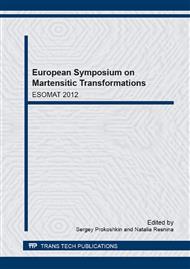p.530
p.537
p.542
p.549
p.554
p.559
p.566
p.573
p.579
Optimization of Superelastic Properties in Titanium-Niobium Alloys Using Short-Time Thermal Treatments
Abstract:
The short-time thermal treatment strategy has been proved to be very efficient in improving the mechanical properties of various titanium based alloys. The mechanical properties of alloys such as Ti-Nb, Ti-Nb-Zr and Ti-Nb-Zr-Sn based alloys, are extremely sensitive to the β phase stability, microstructure and phase constitution. The concept of the short-time treatment is designed to control precisely the material structure (phase precipitation, etc…) without extensive modification of the distribution of alloying elements. This results in reliable optimizations regarding the balance between elastic modulus, pseudo- (super-) elasticity and strength. Currently, the structural evolution mechanisms involved in the STAT are under systematic investigations in the aim of achieving accurate control of the microstructures and optimized balance of mechanical properties.
Info:
Periodical:
Pages:
554-558
Citation:
Online since:
January 2013
Price:
Сopyright:
© 2013 Trans Tech Publications Ltd. All Rights Reserved
Share:
Citation:


